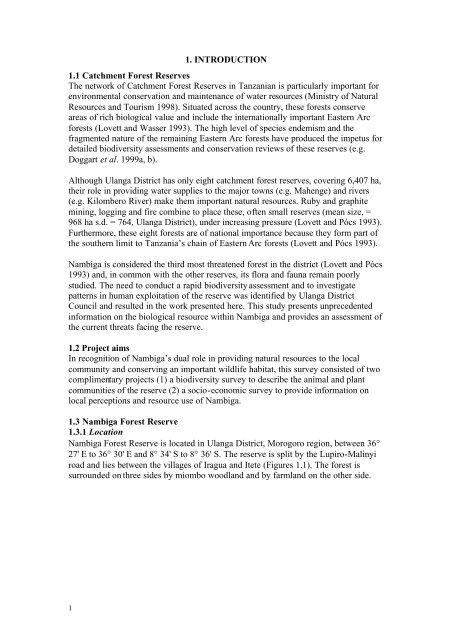Frontier Tanzania Savanna Research Programme
Frontier Tanzania Savanna Research Programme
Frontier Tanzania Savanna Research Programme
You also want an ePaper? Increase the reach of your titles
YUMPU automatically turns print PDFs into web optimized ePapers that Google loves.
1. INTRODUCTION1.1 Catchment Forest ReservesThe network of Catchment Forest Reserves in <strong>Tanzania</strong>n is particularly important forenvironmental conservation and maintenance of water resources (Ministry of NaturalResources and Tourism 1998). Situated across the country, these forests conserveareas of rich biological value and include the internationally important Eastern Arcforests (Lovett and Wasser 1993). The high level of species endemism and thefragmented nature of the remaining Eastern Arc forests have produced the impetus fordetailed biodiversity assessments and conservation reviews of these reserves (e.g.Doggart et al. 1999a, b).Although Ulanga District has only eight catchment forest reserves, covering 6,407 ha,their role in providing water supplies to the major towns (e.g. Mahenge) and rivers(e.g. Kilombero River) make them important natural resources. Ruby and graphitemining, logging and fire combine to place these, often small reserves (mean size, =968 ha s.d. = 764, Ulanga District), under increasing pressure (Lovett and Pócs 1993).Furthermore, these eight forests are of national importance because they form part ofthe southern limit to <strong>Tanzania</strong>’s chain of Eastern Arc forests (Lovett and Pócs 1993).Nambiga is considered the third most threatened forest in the district (Lovett and Pócs1993) and, in common with the other reserves, its flora and fauna remain poorlystudied. The need to conduct a rapid biodiversity assessment and to investigatepatterns in human exploitation of the reserve was identified by Ulanga DistrictCouncil and resulted in the work presented here. This study presents unprecedentedinformation on the biological resource within Nambiga and provides an assessment ofthe current threats facing the reserve.1.2 Project aimsIn recognition of Nambiga’s dual role in providing natural resources to the localcommunity and conserving an important wildlife habitat, this survey consisted of twocomplimentary projects (1) a biodiversity survey to describe the animal and plantcommunities of the reserve (2) a socio-economic survey to provide information onlocal perceptions and resource use of Nambiga.1.3 Nambiga Forest Reserve1.3.1 LocationNambiga Forest Reserve is located in Ulanga District, Morogoro region, between 36°27' E to 36° 30' E and 8° 34' S to 8° 36' S. The reserve is split by the Lupiro-Malinyiroad and lies between the villages of Iragua and Itete (Figures 1.1). The forest issurrounded on three sides by miombo woodland and by farmland on the other side.1
















